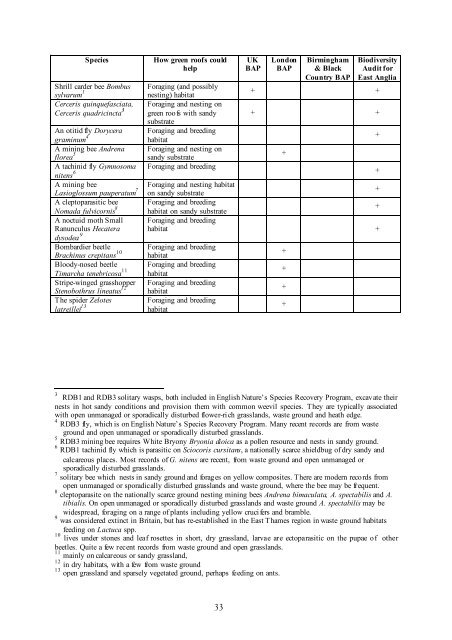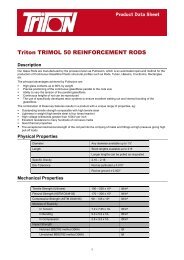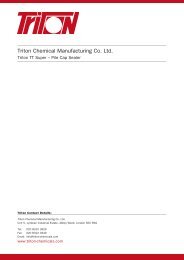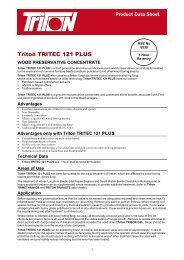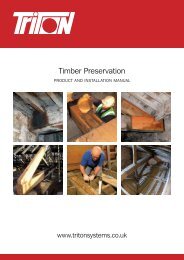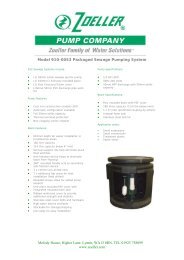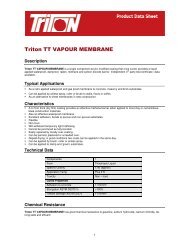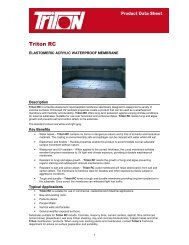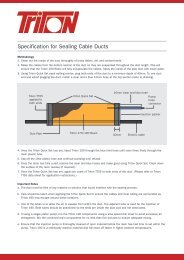Green Roofs - GreenSpec
Green Roofs - GreenSpec
Green Roofs - GreenSpec
- No tags were found...
You also want an ePaper? Increase the reach of your titles
YUMPU automatically turns print PDFs into web optimized ePapers that Google loves.
SpeciesShrill carder bee Bombussylvarum 1Cerceris quinquefasciata,Cerceris quadricincta 3An otitid fly Doryceragraminum 4A mining bee Andrenaflorea 5A tachinid fly Gymnosomanitens 6A mining beeLasioglossum pauperatum 7A cleptoparasitic beeNomada fulvicornis 8A noctuid moth SmallRanunculus Hecateradysodea 9Bombardier beetleBrachinus crepitans 10Bloody-nosed beetleTimarcha tenebricosa 11Stripe-winged grasshopperStenobothrus lineatus 12The spider Zeloteslatreillei 13How green roofs couldhelpForaging (and possiblynesting) habitatForaging and nesting ongreen roofs with sandysubstrateForaging and breedinghabitatForaging and nesting onsandy substrateForaging and breedingUKBAPLondonBAPBirmingham& BlackCountry BAPBiodiversityAudit forEast Anglia+ ++ +Foraging and nesting habitaton sandy substrate+Foraging and breedinghabitat on sandy substrate+Foraging and breedinghabitat +Foraging and breedinghabitatForaging and breedinghabitatForaging and breedinghabitatForaging and breedinghabitat+++++++3 RDB1 and RDB3 solitary wasps, both included in English Nature’s Species Recovery Program, excavate theirnests in hot sandy conditions and provision them with common weevil species. They are typically associatedwith open unmanaged or sporadically disturbed flower-ri ch grasslands, waste ground and heath edge.4 RDB3 fly, which is on English Nature’s Species Recovery Program. Many recent records are from wasteground and open unmanaged or sporadically disturbed grasslands.5 RDB3 mining bee requires White Bryony Bryonia dioica as a pollen resource and nests in sandy ground.6 RDB1 tachinid fly which is parasitic on Sciocoris cursitans, a nationally scarce shieldbug of dry sandy andcalcareous places. Most records of G. nitens are recent, from waste ground and open unmanaged orsporadically disturbed grasslands.7 solitary bee which nests in sandy ground and forages on yellow composites. There are modern records fromopen unmanaged or sporadically disturbed grasslands and waste ground, where the bee may be frequent.8 cleptoparasite on the nationally scarce ground nesting mining bees Andrena bimaculata, A. spectabilis and A.tibialis. On open unmanaged or sporadically disturbed grasslands and waste ground A. spectabilis may bewidespread, foraging on a range of plants including yellow crucifers and bramble.9 was considered extinct in Britain, but has re-established in the East Thames region in waste ground habitatsfeeding on Lactuca spp.10 lives under stones and leaf rosettes in short, dry grassland, larvae are ectoparasitic on the pupae of otherbeetles. Quite a few recent records from waste ground and open grasslands.11 mainly on calcareous or sandy grassland,12 in dry habitats, with a few from waste ground13 open grassland and sparsely vegetated ground, perhaps feeding on ants.33


